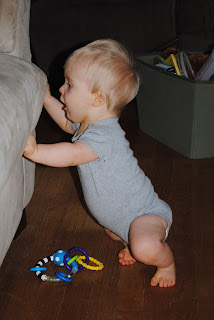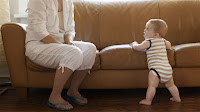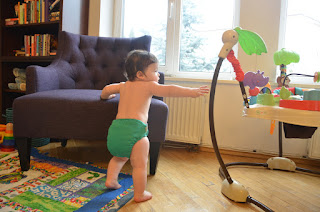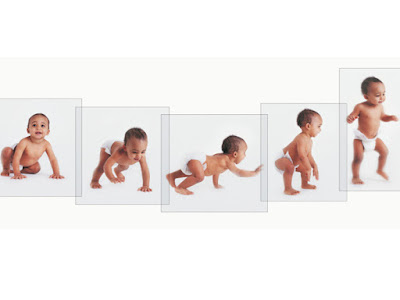There are few things more exciting for a parent than seeing their baby take their first steps! (Well, maybe sleeping through the night......!) When should a child start walking? Most babies start pulling to standing between 10 and 12 months and most children take their first steps before 14 months. If your child is over 15 months and shows NO interest in standing, you may want to talk to your Pediatrician and possibly ask for a referral to your state’s Early Intervention Program for further evaluation.
Progression to Walking:
- Standing with support (parents holding
both hands) or standing holding onto furniture
- Cruising sideways along furniture
- Cruising forward facing with one hand
on furniture
- Cruising between stable objects or
furniture
- Walking with 2 hands held
- Walking with 1 hand held
- Standing alone
- Independent Steps
When babies start crawling they
begin exploring and looking up to see what is within reach. If something tempting is above their eye level, they will try to reach the "treasure" by pulling up to standing.
 |
| Secure all Stairways |
 |
| Dangling Cords and Unstable Furniture |
This is why it is crucial to baby
proof your home before your baby starts crawling and walking!
Any dangling cords should be tucked out of reach or bundled. Any shelf or piece of furniture that is not stable
should be secured to the wall, as a new crawler will try to pull themselves to
standing and the unstable furniture could topple on their head. All stairs
should be gated securely and checked frequently to insure that the gate can’t
be easily shifted.
 |
| Getting to Standing at the Couch |
 |
| Half Kneel to Standing |
A great place to learn to pull to
standing and begin cruising (walking along furniture) is at the sofa or
couch. Get down on the floor near your
baby and the couch, and get their attention with a toy.
Place the toy a few feet away and have them start crawling toward the
toy. (Some
Motivating Toys can be found on our
Website--Click
Here.) When they reach the toy, give them
a minute to play and then gentle remove the toy and place it on the couch. Encourage your baby to crawl near the couch;
if they do not reach up or get themselves into ½ kneel position (one foot on
the floor with knee bent, other knee on the floor), them help them to get to
this position.
 |
| From Floor to Furniture |
If they do not pull
themselves up to standing, give a little lift under their bottoms to
assist. Let them play in standing at the
couch with the toy. Show them how they
can get down from standing “bottom first” by bending at the waist
 |
| Sitting Down from Standing |
and bringing
their head forward and doing a controlled landing on their plump, diapered behind.
Repeat the process of getting to standing through ½ kneeling and sitting down
again until they are able to do it smoothly on their own.
Once your child is able to pull to
standing and sit down, they are ready for cruising. Encourage them to get to
standing with their favorite toy on the couch, then start to shift to toy to
the right or left; if they do not make a sideways step to get to the toy,
assist them to do so by sliding their foot.
Let them bring the second foot over to meet the
first. Let them play with the toy and
then move the toy slightly to the side again, encouraging the sideways stepping
or cruising. Once they reach the end of
the couch, start moving the toy to the opposite side to cruise to the other end
of the couch.
Babies usually cruise
sideways with both hands on the couch.
 |
| Cruising Sideways on the Couch |
 |
| Cruising Forward Facing with 1 Hand on Furniture |
When they are almost ready to walk, they will frequently drop one hand
and start to walk with their body pointed in the direction they are walking,
taking forward steps rather than sideways steps, holding onto the couch or
other furniture with just one hand.
At
this stage you might place a stable chair or coffee table 10 inches from the
couch and put their favorite toy on that new piece of furniture. Encourage the baby to reach toward the toy,
grasping onto the new chair.
 |
| Cruising Between Stable Objects |
Soon the
child will be moving confidently between both pieces of furniture and you can
slowly inch the furniture further away to increase the distance they need to walk. This is called cruising between stable objects.
Most babies are able to walk behind a Baby Push Walker at this stage. Make sure the Push Toy is stable with a wide base. (Check out our
Baby Push Walker--
Click Here!)
 |
Baby Walking Behind a Stable Push Toy
|
Walk next to your baby with your hand guiding and controlling the Walk Behind Toy until your baby demonstrates that they are able to control the toy.
When the baby is moving well
between stable furniture, they are ready to walk with 1 or 2 hands
held.
 |
| Walking with 2 Hands Held |
 |
| Baby Walking with Parents, 2 Hands Held |
 |
| Baby Walking with 1 Hand Held |
If you can get them to grasp just your finger instead of your whole hand,
it makes releasing them a bit easier. As
a therapist, I prefer to aid walking by controlling a child at their shoulders. I stand behind the child and have a parent
call to them from several feet away.
 |
| Using Shoulder Control to Assist |
 |
| Walking with Shoulder Control |
I
give the minimal amount of assistance necessary for the child to walk toward
dad or mom by holding the top of the child’s shoulders. I can give more or less
assistance as needed until the child is able to take those first steps alone. By holding the baby's shoulders or tops of their sleeves, I am in control and can release the child when they demonstrate that they are stable and moving on their own.
 |
| Walking from Dad to Mom |
There is rarely anything more motivating than Mom and Dad. When your baby is showing all the abilities above, they are ready to take those first steps. Have baby stand with their back against Daddy. Position Mommy 3-4 feet away and call to baby.
 |
| Walking Between Parents |
 |
| First Steps to Mom |
She should take those first wobbly steps toward Mom. Praise her and don't make a big deal when she falls--it's all part of the learning process!
Author: Trisha Roberts
www.proeducationaltoys.com
Watch for our next blog,
Copyright © 2016 TNT Inspired Enterprise, LLC,
All rights reserved.
Unauthorized duplication is a violation of
applicable laws.





















I like your idea of walking between furniture. My son had a really hard time letting go of the couch or our hands to take those first steps. If I see another family with an almost walker, I will definitely tell them to try this!
ReplyDeleteWhat a cute baby, this post so helpful because walker are actually not recommended.
ReplyDeleteyou may want to talk to your Pediatrician and possibly ask for a referral to your state’s Early Intervention Program for further evaluation. thebabycelebration.com/best-toys-for-deaf-and-blind-babies/
ReplyDeleteI admire this article for the well-researched content and excellent wording. I got so involved in this material that I couldn’t stop reading. I am impressed with your work and skill. Thank you so much. βρεφικα επιπλα
ReplyDeleteExcellent website you have here, so much cool information!..
ReplyDeletebest baby toys
Wonderful blog, learning to walk is a key step in baby growth, they are so cute
ReplyDelete